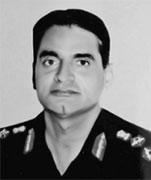The Commander’s Way
 Brig B.L. Poonia (retd)
Brig B.L. Poonia (retd)
Whenever the commanding officer (CO) of a battalion gets killed during an encounter with militants, the news hits the national headlines, triggering a debate on whether it was worth sacrificing a life armed with enormous military experience, when a company commander could have, and should have, carried out the task, since a CO leading company-level operations goes against the conventional military teaching.
So now the question is, is it correct for a CO to lead company-level operations in a counter insurgency (CI) environment? Well, my answer is yes. After all, the command of troops is an art, based on character, ability and power of intellect. The aim has to be to achieve the desired results, and once a CO has been given a task, how he accomplishes it is his prerogative.
Field Marshal Rommel, even as a subaltern, used to unconventionally infiltrate through the enemy lines with a few men. The climax of his career during World War I was reached with the capture of Monte Marajur on the Italian front using such unconventional tactics, for which he was awarded Pour le Mèrite in January 1918, the highest military award of Prussia, corresponding to the Victoria Cross of the United Kingdom.
Leadership in war is among the highest forms of human endeavour. It requires superlative skills, a person to whom other men would unhesitatingly entrust their lives in battle. This can happen only when they are assured that he can willingly place his life in peril, to save their lives, and can lead them through personal example. This is the way for a CO to develop unflinching faith among his subordinates, which inspires the soldiers under his command to place their lives at his disposal, without a second thought or blinking an eyelid.
Moreover, a leader must have something more than normal. He must have a sixth sense, an intuition, developed through experience, professional competence, sharp judgement, self-confidence, and an ability to take calculated risks and quick decisions. Field Marshal Rommel had it in him and he often led from the front. During the African Campaign in World War ll, when the British raided his headquarters, 100 kilometres behind, Rommel was riding a tank in the vanguard squadron of the advancing column.
Field Marshal William Slim used to reach the frontline troops during crucial battles, even as a Corps Commander during the Burma Campaign. The ultimate aim of adopting such unconventional methods is to minimize human losses by ensuring the economy of effort, and thereby raising the morale of troops, which is one of the principles of war, with the ultimate aim of increasing the probability of success. Moreover, what is the use of studying military history campaigns and character studies of some of the famous military commanders, for various promotion and competitive examinations, if we are not prepared to learn the lessons and implement the same on the ground?
In any case, different situations demand different solutions. When you command an infantry battalion or any other army unit, which is well trained as a cohesive unit to carry out CI operations, there is no problem, but when you are sent on deputation to command an Assam Rifles Battalion, things are not the same, and your challenge increases manifold. However, before proceeding further, let me explain that Assam Rifles, though under the ministry of home affairs, is commanded by army officers on deputation. Hence, it is the only organisation in the country that ideally qualifies to be referred to as a paramilitary force. It is an excellent organisation with fantastic troops, but the problem lies with leadership, especially when you do not have a cohesive team of officers trained together. You have a mix of officers from all arms of the Indian Army, temporarily posted on deputation from different regiments, with a few Assam Rifles cadre officers, who are all through ranks. During the mid-Nineties, the Second-in-Commands (2ICs) of the Assam Rifles battalions used to be emergency commission officers, commissioned during the period 1963 to 1965, but released from the army after five years, and absorbed by the Assam Rifles.
Now I will briefly narrate the challenges that I faced during the command of an Assam Rifles Battalion during the peak insurgency period of the mid-nineties while conducting operations in ‘Operation Orchid’. An Assam Rifles battalion has six rifle companies, as against four in an infantry battalion of the Indian Army. In my case, the two companies were deployed in Tripura, with the Main Battalion Headquarters in Agartala. Both these companies had been deployed to occupy the areas vacated by two battalions, which had moved out of Tripura to other states like Nagaland or Manipur, since the Tripura insurgency was relatively low in intensity. Hence these two companies were spread out far and wide, the farthest post from Agartala being about 200 kilometres away, on the Tripura-Mizoram border.
The remaining four companies with Tactical Battalion Headquarter
Subscribe To Force
Fuel Fearless Journalism with Your Yearly Subscription
SUBSCRIBE NOW
We don’t tell you how to do your job…
But we put the environment in which you do your job in perspective, so that when you step out you do so with the complete picture.








